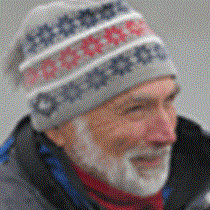Hood and Hanus Bay
Wispy clouds draped over the forested ridge lines of Admiralty Island as we slowly and quietly pushed through the glassy water. Everyone’s binoculars were trained on a dark lump. As we drew closer to it someone said, “No, it’s a stump.” Soon afterwards, “There’s one! Look in the grass at the forest margin.” And so it went for the first part of the day searching for and finding brown bears.
The water was still glassy as we left Hood Bay and encountered blows from humpback whales. Their spray floated in the still air. At least three separate leviathans dove into a group of krill that was somewhere below our ship.
In late morning we encountered more whales, and the fun began. Sixteen humpbacks fed on herring in a cooperative group. They execute this complex maneuver by first finding the herring. Then, they dive below the fish, flash the white undersides of their pectoral flippers at them, and drive them upwards. A large ring of bubbles is then blown around the fish school from about 50 feet down. The bubbles rise to the surface as a column and frighten the fish into the center. Whales follow up from below, emitting a series of wavering calls that scare the herring into a tight group. They rise upwards with the whales close behind. Sixteen gigantic open mouths, one following the other, engulf the trapped fish at the surface. Catastrophe and feast play out as predator consumes prey. These humpbacks take in a ton of food a day as they replenish their fat stores.
During the afternoon we either hiked along a salmon-filled stream and paddled kayaks through intertidal channels. We walked through gushy mud, stepped over big piles of bear poop, and got stuck in kayaks on intertidal barnacles. Wet dripping forests, seas full of life, and verdant wildness began to sink into our souls.
Wispy clouds draped over the forested ridge lines of Admiralty Island as we slowly and quietly pushed through the glassy water. Everyone’s binoculars were trained on a dark lump. As we drew closer to it someone said, “No, it’s a stump.” Soon afterwards, “There’s one! Look in the grass at the forest margin.” And so it went for the first part of the day searching for and finding brown bears.
The water was still glassy as we left Hood Bay and encountered blows from humpback whales. Their spray floated in the still air. At least three separate leviathans dove into a group of krill that was somewhere below our ship.
In late morning we encountered more whales, and the fun began. Sixteen humpbacks fed on herring in a cooperative group. They execute this complex maneuver by first finding the herring. Then, they dive below the fish, flash the white undersides of their pectoral flippers at them, and drive them upwards. A large ring of bubbles is then blown around the fish school from about 50 feet down. The bubbles rise to the surface as a column and frighten the fish into the center. Whales follow up from below, emitting a series of wavering calls that scare the herring into a tight group. They rise upwards with the whales close behind. Sixteen gigantic open mouths, one following the other, engulf the trapped fish at the surface. Catastrophe and feast play out as predator consumes prey. These humpbacks take in a ton of food a day as they replenish their fat stores.
During the afternoon we either hiked along a salmon-filled stream and paddled kayaks through intertidal channels. We walked through gushy mud, stepped over big piles of bear poop, and got stuck in kayaks on intertidal barnacles. Wet dripping forests, seas full of life, and verdant wildness began to sink into our souls.




